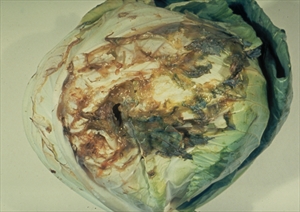Basal stem rot
Pacific Pests, Pathogens, Weeds & Pesticides - Online edition
Pacific Pests, Pathogens, Weeds & Pesticides
Chinese cabbage stalk rot (101)
Pectobacterium carotovorum subsp. carotovorum; previously, Erwinia carotovora subsp. carotovora, and Erwinia aroideae. Other bacteria species may also be present in the soft rots.
Asia, Africa, North, South, and Central America, the Caribbean, Europe, Oceania. It is recorded from Australia, American Samoa, New Zealand, and Papua New Guinea. In Fiji, it is recorded on Chinese cabbage as Erwinia species. In Papua New Guinea, Erwinia carotovora pv. carotovora causes a "leaf wilt and petiole base rot" of Chinese cabbage. In Solomon Islands, Erwinia carotovora pv. carotovora is the likely cause of a soft rot of taro corms in storage (see Fact Sheet no. 289), as well as Chinese cabbage stalk rot (unconfirmed). In Federated States of Micronesia, Palau and Marshall Islands, Erwinia carotovora pv. carotovora causes a soft rot of banana (see Fact Sheet no. 214).
Chinese cabbage, and many other plants are hosts, e.g., banana, head cabbage, capsicum, carrot, celery, cucumber, lettuce, and potato.
The bacteria live in the soil. Infections occur through wounds made by insects, and those made at planting or when weeding. The disease usually starts on the underside of the lower leaves close to the soil. A grey watery rot develops rapidly with a strong smell (Photo 1). The rot spreads quickly to the entire plant and it collapses and dies. As the plants die the bacteria are released into the soil. The bacteria are also spread in rain splash. Spread occurs rapidly between plants (Photo 2).
A wet soft rot develops at the base of the leaf stalks. Serious losses can occur in Chinese cabbage crops, especially during hot wet weather. The disease also occurs on head cabbage (Photo 3).
Look for leaves that have wilted, and show grey rots at the base of the stems. This is called a water-soaked symptom. First, the outer leaves wilt, and then the whole plant.
CULTURAL CONTROL
Cultural practices are important in preventing outbreaks of this disease. There is no treatment for the affected crop, but for future crops carry out the following cultural practices:
Before planting:
- Avoid planting in soil that becomes waterlogged: plant Chinese cabbage on raised beds.
- Do not replant land with Chinese cabbage, especially if basal stem rot occurred in the previous crop, or if it is essential to use the same land, allow a few months for the crop debris to decompose before planting another crop of Chinese cabbage.
During growth:
- Do not plant Chinese cabbages too close to each other: allow wind movement between the plants.
- Mulch plants with, e.g., straw or dried grass; this is important as it not only conserves water during dry times, but also reduces the chance that bacteria will be splashed during heavy rains from diseased to healthy plants.
- Avoid over-head irrigation, use drip irrigation in preference.
- Clean and disinfect (use household bleach) equipment used in harvesting.
- Be careful when weeding the plants so as not to damage the leaves and allow entry of bacteria.
- Remove plants with signs of stalk rot as soon as it appears, and burn or bury them deeply.
After harvest:
- Collect crop debris and burn or bury it deeply in the soil before a new crop is planted.
- Rotate with other crops that are resistant to this disease, e.g., beans, cucumbers or tomatoes. Ideally, use a crop rotation of 2-3 years.
RESISTANT VARIETIES
The variety Pak Choy is especially susceptible to this disease, so try other varieties of Chinese cabbage.
CHEMICAL CONTROL
This is not an option for this soil borne disease, unless the problem is associated with soil insects. In this case, use synthetic pyrethroids.
AUTHORS Helen Tsatsia & Grahame Jackson
Information from (CABI (2019) Pectobacterium carotovorum subsp. carotovorum (bacterial root rot of sweet potato). (https://www.cabi.org/cpc/datasheet/21913); and from Shaw DE (1984) Microorganisms in Papua New Guinea. Research Bulletin No. 33. Department of Primary Industry, Port Moresby. Photo 3 Queensland Primary Industries and Fisheries, DAF Collection, Queensland, Australia.
Produced with support from the Australian Centre for International Agricultural Research under project PC/2010/090: Strengthening integrated crop management research in the Pacific Islands in support of sustainable intensification of high-value crop production, implemented by the University of Queensland and the Secretariat of the Pacific Community.






